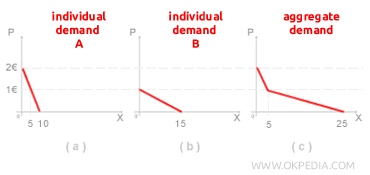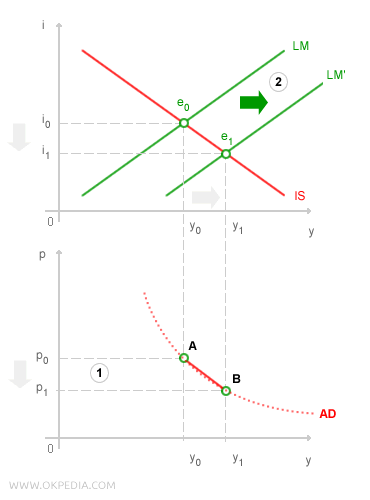Aggregate Demand Curve
The aggregate demand curve is a graphical representation of market demand plotted on a Cartesian plane. It is constructed by summing up the individual demand curves of all consumers. The aggregate demand curve shows the relationship between the price of a good and the aggregate demand function, which represents the total quantity demanded by all buyers. At each price level, the quantities demanded by every consumer are added together. For example, if we consider two consumers, A and B, and a good X, the aggregate demand curve can be constructed as follows:

Curves (a) and (b) represent the individual demand curves for good X, corresponding to consumers A and B, respectively. To derive the aggregate demand curve (market demand) for good X, the quantities from each individual demand curve are added for each price level. The process starts by summing the intercepts on the horizontal axis (X-axis). In this case, curve (a) has an intercept of 10, while curve (b) has an intercept of 15. Adding these values gives an aggregate intercept of 25 (10 + 15) on the X-axis. At a price of €1, consumer A demands 5 units, and consumer B demands none, resulting in a total demand of 5 units. For price levels above €1, the aggregate demand curve follows the trajectory of individual demand curve (a) since curve (b) contributes no demand. When dealing with multiple consumers, the aggregate demand curve takes the following form:

The aggregate demand illustrates, on a graph, the spending patterns of individual consumers or households. The demand curve maps all possible combinations of price levels and market demand quantities for a specific good. From a macroeconomic perspective, the aggregate demand curve also encompasses business investment demand (e.g., machinery, equipment) and public sector demand for goods and services. In macroeconomic models, the aggregate demand curve typically represents the relationship between price (p) and income (y) and is commonly referred to as the AD curve.


 Constructing the Aggregate Demand Curve. The aggregate demand curve can also be derived from the IS-LM model by mapping each macroeconomic equilibrium to its corresponding price level. This method allows us to plot points with coordinates (y, p) on the income-price graph, aligning with each equilibrium in the IS-LM model. Deriving the aggregate demand (AD) curve from the IS-LM model also bridges the IS-LM framework with the AD-AS model. This connection provides deeper insights into the effects of economic policies by removing the assumption of constant prices.
Constructing the Aggregate Demand Curve. The aggregate demand curve can also be derived from the IS-LM model by mapping each macroeconomic equilibrium to its corresponding price level. This method allows us to plot points with coordinates (y, p) on the income-price graph, aligning with each equilibrium in the IS-LM model. Deriving the aggregate demand (AD) curve from the IS-LM model also bridges the IS-LM framework with the AD-AS model. This connection provides deeper insights into the effects of economic policies by removing the assumption of constant prices.
